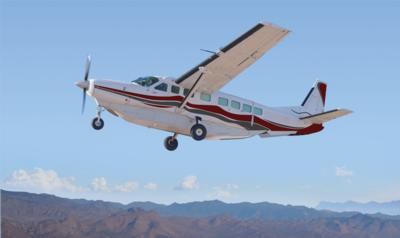2022 Snohomish Crash Now Sees 3 Survivors' Lawsuits
A woman widowed after a test flight gone fatal has sued the manufacturer, and others associated with the accident, alleging flawed design and development.

The aircraft crashed in Washington state in 2022, when a Cessna 208 test mule broke up in mid-air. The woman's husband, a 33-year-old aerospace engineer, was aboard along with 3 others. He and the crew were gathering data as a part of the aerodynamic development process for an active aero system when the right wing reportedly separated from the aircraft. While the investigation remains ongoing at the NTSB; the wife, Danielle Martin, filed suit in King County Superior Court. Two other families affected filed similar lawsuits to little public note last summer, their trials are scheduled to begin in June. Newton's suit includes Textron; Ace Aviation, a local MRO company; and Raisbeck Engineering, the company driving the tests as part of its aerodynamic development program.
“Wings aren’t supposed to fall off,” said Newton's lawyer. “There could be any number of causes of that, but it certainly wasn’t something that was in our client’s husband’s control.”
In the report issued last year, the NTSB described the test campaign in the days leading up to the crash:
"The operator, Raisbeck Engineering, holds the Supplemental Type Certificate for an aerodynamic drag reduction system on the Cessna 208B. The accident flight was part of the testing for Raisbeck to expand the applicability of that DRS to the Cessna 208B EX model. The airplane began flights to support the flight-test three days before the accident. The flights on the first day, consisting of three flights, totaled 1.1 hours and included a pilot familiarity-flight and a ferry flight to have the airplane’s weight and balance performed. Two days before the accident, the flight-test data-collection flights. Those included two flights, equating to 4.6 hours flight time, that were conducted to gather baseline data for both mid center-of-gravity (CG) cruise flight and forward CG stall speeds. The day prior to the accident, two test flights were performed with the accident test-pilot and the accident aft-seated testing personnel (different right-seated pilot). The first flight, totaling 1.2 hours, was
testing aft CG static stability. The last flight that day ended short, totaling 1.4 hours, with only about half of the test plan (card) completed because an aft crewmember was feeling ill. The purpose of the accident flight was to complete that test card from the day prior, which was baseline testing of the airplane’s aft CG stall characteristics."
On the day of the crash, the investigation notes what those on the ground reported.
"Witnesses reported that they observed the airplane break-up inflight and watched pieces floating down. The airplane then descended in a nose-low near-vertical corkscrew maneuver toward the ground. Several witnesses reported seeing a white plume of smoke when they observed the airplane break into pieces. A security camera recorded a low-quality image of the airplane rotating about its longitudinal axis in nose-low attitude."
 ANN's Daily Aero-Term (12.08.25): Decision Altitude (DA)
ANN's Daily Aero-Term (12.08.25): Decision Altitude (DA) ANN's Daily Aero-Linx (12.08.25)
ANN's Daily Aero-Linx (12.08.25) NTSB Final Report: Piper PA-31T3
NTSB Final Report: Piper PA-31T3 Aero-News: Quote of the Day (12.08.25)
Aero-News: Quote of the Day (12.08.25) Airborne-Flight Training 12.04.25: Ldg Fee Danger, Av Mental Health, PC-7 MKX
Airborne-Flight Training 12.04.25: Ldg Fee Danger, Av Mental Health, PC-7 MKX



